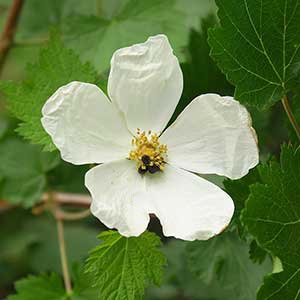Rubus bartonianus
Rubus laciniatus
Barton's raspberry, bartonberry
cut-leaf blackberry, cutleaf evergreen blackberry, evergreen blackberry
erect, sparsely short-hairy, glabrescent, eglandular, not pruinose.
biennial, arching, sometimes creeping, glabrate to moderately hairy, sparsely to densely sessile- to short-stipitate-glandular, not or weakly pruinose;
prickles moderately dense to dense, suberect to retrorse or hooked, stout, 2–8 mm, broad-based.
deciduous, simple;
stipules lanceolate, 4–6 mm;
blade cordate to broadly ovate, (2–)2.5–4(–5) × (2.5–)3.5–4.5(–5.5) cm, base deeply cordate, 3–5-lobed, lobe apices acute to obtuse, margins coarsely doubly dentate, abaxial surfaces glabrous or sparsely hairy, eglandular or sparsely stipitate-glandular.
evergreen to late-deciduous, ternate or palmately compound;
stipules filiform, 5–15 mm;
leaflets 3–5, terminal ovate to elliptic, 6–12 × 7–12 cm, base rounded to cordate, usually deeply, rarely shallowly, lobed, margins coarsely serrate to doubly serrate, apex acuminate to short-attenuate, abaxial surfaces with hooked prickles primarily on midvein, moderately to densely hairy, eglandular or moderately sessile- to short-stipitate-glandular primarily on midvein.
1-flowered.
terminal, 5–25-flowered, thyrsiform.
moderately hairy, eglandular or sparsely stipitate-glandular.
prickles moderate to dense, erect to reflexed, densely hairy, moderately to densely sessile- to short-stipitate-glandular.
bisexual;
petals white, obovate, (15–)20–25 mm;
filaments filiform;
ovaries glabrous, styles clavate, villous.
bisexual;
petals white to pink, elliptic to obovate, 8–15 mm;
filaments filiform;
ovaries usually apically hairy.
deep red, hemispheric, to 1 cm;
drupelets 10–30, coherent, separating from torus.
black, globose to subcylindric, 1–1.5 cm;
drupelets 25–60, strongly coherent, separating with torus attached.
= 28.
Rubus bartonianus
Rubus laciniatus
Of conservation concern.
Rubus bartonianus is distinguished from the other flowering raspberries within its geographic range by its erect, unarmed stems, relatively small, simple leaves with acute to obtuse lobes, deeply cordate bases, sparsely hairy or glabrous abaxial surfaces, relatively large flowers with white petals, and densely long-hairy, clavate styles. The leaves superficially resemble those of Acer glabrum or some species of Ribes.
Rubus bartonianus is most similar to R. neomexicanus but especially R. deliciosus. The species is known only from the Snake River Canyon of Idaho and Oregon.
(Discussion copyrighted by Flora of North America; reprinted with permission.)
Rubus laciniatus is the only blackberry in the flora area that has leaflets so deeply lobed and dissected or has 3-lobed petals. Rare individuals bearing relatively unlobed leaflets and perianth parts may be part of the natural variation of this species or be hybrids with some other species. Putative natural hybrids have been reported with R. bifrons (as R. procerus; R. K. Bammi and H. P. Olmo 1966). Such unusual plants of R. laciniatus would be distinguished from the native blackberries by their thyrsiform and notably stipitate-glandular inflorescences and evergreen to late-deciduous leaves.
Although widely introduced in the flora area, Rubus laciniatus is a less aggressive weed than R. bifrons.
(Discussion copyrighted by Flora of North America; reprinted with permission.)
- Local floras:
BC,
CA,
OR,
WA
- Local Web sites:
CalFlora,
CalPhotos,
Flora NW,
Go Botany,
IL Wildflowers,
MD Biodiversity,
MI Flora,
MO Plants,
PNW Herbaria,
Turner Photog.
WildflowerSearch
iNaturalist (observations)
USDA Plants Database
- LBJ Wildflower Center
- SEINet
- Plants of the World Online
- Encyclopedia of Life
- Wikipedia
- Google Image Search


